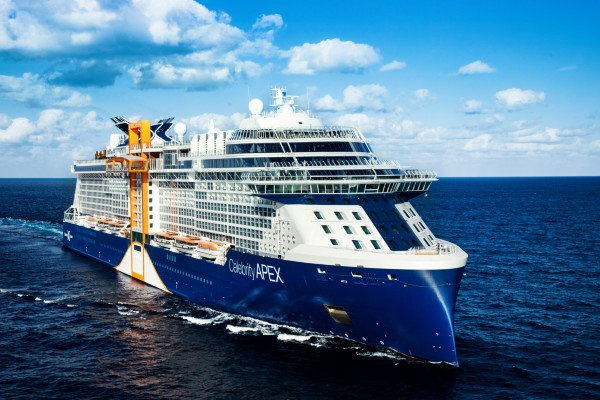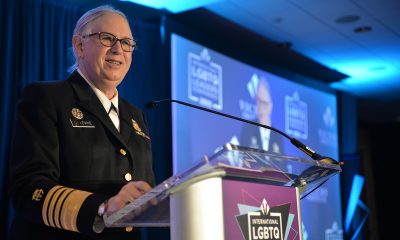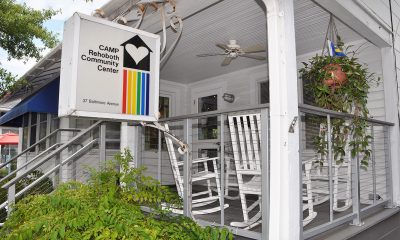Opinions
Blogging my first overseas vacation since COVID
Chronicling life aboard Celebrity APEX

I will be blogging a number of times during my two-week transatlantic cruise and sharing my thoughts and experiences.
The first thing I found is boarding during a pandemic is a little different. People were given specific boarding times yet most arrived at the port when it was convenient for them as many had early check-out times from their hotel or Airbnb in Barcelona. Celebrity didn’t turn anyone away. There was no Wi-fi at the entrance to the terminal so things got a little complicated as many had the information needed on their iPhone Celebrity app. It worked out and when you got inside to the counter they shared a Wi-fi connection.
I knew in advance from a Facebook connection, some childhood friends whom I hadn’t seen in 21 years were going to be onboard. We ended up arriving at the terminal at the same time and caught up for the next hour and a half as we progressed through the boarding process. We all had to take a Covid test and only those with negative results could board. Of the approximately 1,300 people boarding, less than half the possible number for a full ship, I didn’t hear of anyone getting a positive result.
When my negative result came back I was allowed to board and went to find my stateroom on deck 11. The key was at the door with all my information on it. Celebrity was doing everything to limit crew-to-passenger contact. We were asked to keep masks on in all indoor spaces except when eating or drinking, which on a cruise is often, and the crew are all wearing masks. Luggage was delivered to the door.
Shortly after entering my beautiful stateroom there was a knock at the door and my stateroom attendant, Lenie, had come to introduce herself. She didn’t come in but explained how I could reach her anytime and for safety she would only come into the room when I was out. We chatted for a few minutes and I found out she was from the Philippines, had three children, and had worked for Celebrity for 20 years. She was both charming and efficient.
I then took a walk around the ship and was duly impressed. It is beautiful. I walked through the huge buffet where people were happily eating lunch and saw instead of serving yourself there were servers behind each station filling people’s plates. All passengers had on their masks when getting food, as did the crew serving them. It made for a very safe feeling.
Instead of a group muster each passenger was asked to go to their assigned muster station where you were met by staff who explained emergency procedures. You also had to look at a video on the Celebrity app and were then logged in and confirmed you had done so. All efficiently and safely done.
Then I headed to the sail-away party my travel agent, and friends, Scott Moster and his husband Dustin, were hosting in the Iconic suite. The suite has everything from a peloton cycle to a hot tub for eight. It is incredible. I had the chance to catch up with old friends I had sailed with before the pandemic. Then it was a quick tour of the spa and gym open twenty-four hours a day. A way to assuage guilt over all the food and drink. Then back to the stateroom to finish unpacking and change for dinner with good friends in one of the specialty restaurants, EDEN. That meant long pants and a shirt with a collar. That’s as formal as required on this cruise.
The food was superb and we got to meet the chef, Nicholas. An interesting guy who I will interview during the cruise. The menu was a combination of fresh fish, lobster, to filet mignon, all interestingly prepared.
After dinner it was a stop at the Martini bar where a large group of LGBTQ friends had gathered along with some who would become friends. I was surprised when a guy came over and gave me a hug. I didn’t recognize him with his mask on but turned out he was another friend from my past I hadn’t seen in years. It is clearly a small world and the gay world seems even smaller.
Finally headed to my stateroom around midnight, where turndown service had been done, to get some sleep and prepare for day two, and our first stop, Alicante.
Day two and three on the Celebrity APEX
Time flies when on a cruise; maybe it’s the endless food and drink. All passengers received a letter in their room telling us we would need to report for a Covid test on day 5 the first at-sea day before we get to the Canary Islands. I pre-scheduled mine just before what I planned as my first hour at the gym. I expect to go to the gym on all sea days and there will be eight of those.
Each morning I have had coffee, a bagel and orange juice delivered to the stateroom. I always miss that knock on the door each morning when I am home but then I would miss my daily coffee at Java House so I guess it’s OK.
On day two we stopped at our first port, Alicante, on Spain’s Costa Blanca. I was truly surprised at how beautiful the city is. I joined friends for what turned out to be a three and a half hour walk as we were allowed off the ship on our own without booking a tour. We visited churches and the main market in town. We strolled along the beach and the harbor with great walking and bicycle paths. Alicante is a wonderful mix of old-world charm and modern amenities. One friend ventured up to the castle, Castillo de Santa Barbara, but since the elevator (the easy way up) wasn’t working and it’s a very long, steep climb up the mountain I passed. We arrived back at the ship around 1 p.m. and headed to the Mast bar on deck 14 for burgers and fries. Then some time back in the stateroom before heading to the martini bar for a drink and then to the beautiful APEX theater to see the Shamrock Tenors, four Irish performers who are not only talented but cute to boot.
We decided to try one of the regular restaurants, those not needing reservations and chose Normandy. The food was good and I had shrimp cocktail, rigatoni, and cherries jubilee for dessert.
After dinner it was up to the Rooftop Garden for ‘Silent Disco’. That is where you get a set of headphones with a few channels of disco music, and you dance to the music only you can hear. It’s really fun but by 11:30 my knees gave out and it was off to bed.
Day three dawned nice and sunny and we were docked in Cartagena, located in the autonomous of the region of Murcia. I had an 8:45 excursion and again had breakfast delivered to the room. We were instructed to head to the theater to meet the tour group and sign in for our ‘Journey to Murcia’. Murcia is a city in south-eastern Spain, the capital and most populous city of the Autonomous Community of the Region of Murcia, and the seventh largest city in the country, with a population of 447,182. It is about a forty-minute drive from the port. It is a fascinating city with an incredible history from the Romans to and Moorish influence. There is a beautiful cathedral, isn’t there one in every Spanish city? This being a national holiday in Spain most of the shops were closed saving some on the tour a lot of money. We strolled around the city with our guide giving us a running commentary on its history for about an hour and a half. She was a little hard to understand because not only did she have a heavy accent but she spoke really fast. But it was still fun and we did learn a lot. We made a second stop outside the city at another church where a wedding was being officiated. The bride was beautiful. Then we headed back to the ship for an early departure. Our tour was the last onboard and we sailed not more than thirty minutes after we got there.
Then it was off to the captain’s reception. I had the chance to chat a few moments with the Captain Panagiotis Skylogiannis, who is as charming as are most Greek men. We also met the rest of the senior crew who run the ship. Many said they would be more than happy to sit and get a cup of coffee with me during our at-sea days so I can interview and write about them.
Then it was back to my stateroom again to prepare for another tough night of food and drinking. We went to see Andrew Derbyshire in the theater for the 7:30 show and then to dinner at Cyprus. After dinner Celebrity hosted the first LGBTQ+ event of the cruise at the EDEN bar. A large crowd showed up, not all gay but they all knew where the fun people would be. The entertainers all showed up there as including the Shamrock Tenors, four talented Irish guys and Andrew Derbyshire, a British actor and singer. We chatted and I will meet him for coffee to do a column on him.
Then about midnight it was back to the stateroom for what some of my friends on board called an early night. Morning would have us docking in Cadiz and we had a private tour planned for over 20 of the people who had booked the trip with Scott Moster, travel agent extraordinaire, taking us to the city of Seville.
Days four and five on the Celebrity APEX
Day four dawned warm and partially sunny as we docked in the port of Cadiz. This was the day we had our private tour of Sevilla planned. The itinerary had been set by two of my friends, Rob Robertson and his husband Carlos Taylor. Carlos lived for a time in Sevilla as a child and has a big family still here. Celebrity, by agreement with our travel agent Scott Moster, made the planned itinerary a formally sponsored tour.
At 8:45 our group of mostly gay and lesbian travelers left the ship for the hour and forty-five-minute bus ride to Sevilla. Our guide described the city and gave us its history as we traveled to our destination. Scott also had the foresight to bring along a few bottles of champagne and orange juice and we were treated to mimosas along the way.
Once in Sevilla were met by a second guide and given electronic devices and earphones so we could follow along as we took a two hour walk to see the sights which included the incredible Plaza de España in the Parque de María Luisa. It was built in 1928 for the Ibero-American Exposition of 1929. It is a landmark example of Regionalism Architecture, mixing elements of the Baroque Revival, Renaissance Revival and Moorish Revival styles of Spanish architecture. Plaza de España has been used as a backdrop in a number of films including Starwars. It is very impressive.
From there we headed to the Royal Palace and its beautiful gardens and then it was off to the Cathedral of Saint Mary of the See, better known as, Seville Cathedral. It was registered in 1987 by UNESCO as a world heritage site along with the adjoining Alcazar complex. It is the fourth largest church in the world as well as the largest Gothic church and is particularly ornate with over forty-five individual chapels and two huge organs. Christopher Columbus and his son Diego are buried in the cathedral.
Because we spent so much time at these sites we were very late for lunch at the restaurant Carlos had chosen; one owned by friends of his family. They welcomed us with charcuterie and cheese plates, wine, beer and sangria. However, the rest of lunch ended up as takeout as we were really late and our ship was scheduled to leave port at 4:45 and we had been told to be on board no later than 4:30. We double-timed it back to our bus and headed for the port. All went well until we hit a traffic jam and sat for about fifteen minutes. It was increasingly clear we wouldn’t be on-time. Our guide was getting nervous and he called the ship and someone erroneously told him they would sail without us.
Meanwhile our trusty travel agent Scott was on the phone with his Celebrity contact who confirmed as this was an official tour they couldn’t leave without us. Once again we were the last people up the gangway and about five minutes after the last person was onboard the engines started up. The Captain had made an announcement to all the reason they may be leaving late was us. After that excitement it was a great evening with dinner at Cyprus and then a show. The hard life onboard ship continued.
Day five was our first sea-day. No tours and no rushing. For me it was early morning writing and coffee delivered to the room. Then my required covid test and off to the gym. The half hour on the Lifecyle was easy because I was looking out at the sea. The gym isn’t large and because of covid you could only use every other machine. But with only half the number of passengers on board that worked. The gym is open twenty-four hours a day. After my workout I met friends at the buffet for a lite lunch because of course it was crucial to gain back the few calories I may have lost working out. Then it was a lazy day, the kind I love when cruising. I had arranged coffee with Andrew Derbyshire, one of the talented entertainers onboard, to interview him for a column I will write. He is a really nice guy who will be getting off the ship in the Canary Islands; not being an American citizen, he wouldn’t be allowed into the US even though fully vaccinated until November 8th and we dock on October 24th.
Evening began with a Celebrity scheduled LGBTQ+ happy hour and then a nice dinner at the Rooftop Garden, another of the specialty restaurants. Then on to The Club, one of the entertainment venues, to hear Andrew sing. He had the whole room up and dancing, even me. All-in-all another great day onboard Celebrity APEX.
Day Six begins my sea-days on the Celebrity APEX
I woke on day six to a hazy sky and our ship heading to dock in Tenerife. I had been there before and was sad that we were not going to be allowed to head out on our own. There were a number of tours scheduled but I decided to stay on the ship. It was a wonderful lazy day of writing, the gym, and just finding a nice place to sit and read. First though I would have a long lunch with Cheryl and Jeff in the Café, which is the buffet. They are my childhood friends who are onboard. We exchanged old pictures from our iPhones and talked about people we grew up with.
The EDGE series of Celebrity ships, which includes the EDGE, the APEX which I am on, and the upcoming BEYOND scheduled to make its inaugural sail next April, have what is called the Magic Carpet. It is a lounge that can be moved up and down on the side of the ship. On day six it was on deck 14 and it was the perfect place to sit and read. This would be my life for the next seven days at sea. It is the part of the cruise I like the best.
Scott and Dustin invited us all to a sail-away party in their suite at 4:30 and we watched as our ship sailed out of Tenerife for the seven-day crossing to Ft. Lauderdale. Lazy days and fun nights ahead for all of us. On this day Celebrity had scheduled two LGBTQ+ events, one a meet and greet at 6 pm and a second LGBTQ+ PRIDE event at 10:30. Between the two there was a show in the Theater, UPTOWN, three talented young men dancing and singing to Motown and other music from groups who had sung in the famous New York, Apollo theater. Then dinner at the Steak House, another specialty restaurant.
At the evening LGBTQ+ event we met some of the new cast members of the shows replacing those who had to leave the ship in Tenerife. I ran into another person on the ship I first met years ago in DC, Tareq Salahi, known at the time as part of the couple who crashed a White House dinner. His first wife was on the very short-lived series ‘The Housewives of Washington, DC.
On day seven I woke up to a hazy day at sea, calm waters which we can only hope will be replicated for our whole Atlantic crossing. I started my day going to a talk given by Melinda Bates, who had written a book on the Clinton Administration where she served eight years in the visitor’s office of the White House. I had met her on a previous cruise and had lunch with her so really went just to say hello. Then it was going to be what I looked forward to; gym, writing, reading, eating and drinking, and just being lazy in luxurious surroundings with fun people. What more can anyone ask for.
Seven Sea-days on Celebrity APEX
The sea-days on Celebrity APEX have been as wonderful as I anticipated. The knock on the door every morning at 7:30 a.m. with my coffee delivered by a smiling, at least his eyes are as he is wearing a mask, room service waiter. Then a couple of hours doing the second edit of the book I am writing. Somehow being at sea has given me the head space I needed to get back to it. Then off to the gym.
Despite the apparent incompetence of the Celebrity PR agency, I did get the chance to meet the Captain on the second day of my cruise and he agreed to sit down for a short interview. He is a charming and totally open guy willing to talk about his life. I will be doing a column on the interview shortly after I am off the ship.
He even agreed to set up a tour of the bridge for me and friends Rob and Carlos. It was arranged by Icaro, the concierge, a charming Brazilian. We were met outside the bridge by security and wanded down. The bridge is larger than I thought it would be and the very nice 2nd mate Alex, took time to give us a detailed explanation of how they steer this beautiful ship. In some ways it looks like a little more complicated video game. But then those playing video games aren’t responsible for the lives of a crew of 1,250 and nearly 3000 passengers when the ship is full.
The days at sea pass quickly, which is sometimes surprising when you are really doing nothing but being lazy and figuring out what beautiful venue to go to for your next meal or a drink. The Martini Bar or Café Al Bacio are some of the great places to drink and relax on the ship.
Our ever-attentive travel agent Scott and his husband Dustin hosted another party in their suite, the Iconic Suite, and I met some people I hadn’t yet seen in the past days onboard. Some of them signing up with Scott to go on next year’s October 29th APEX transatlantic cruise out of Rome. I am one of them and have even given a deposit for the October 30th 2023 transatlantic cruise on The BEYOND, Celebrity’s newest ship which will set sail on its first cruise in April of 2022. It is amazing how addictive cruising can be but I guess if you need to have an addiction this isn’t a bad one to have.
The Iconic suite is located in what is called the ‘Retreat’ on the ship. It is the more expensive suites and villas with their own restaurant, sun deck, bar and pool. While I can’t afford to book a stateroom in the Retreat I am lucky some of my friends can. They have invited me to join them there occasionally for a drink and dinner.
Reality is the rest of the ship is just as beautiful and on this cruise, which sailed with less than 50% capacity, it is especially nice. The five specialty restaurants are fun to go to and the regular dining rooms are great. In all of them you can have filet mignon or lobster, among a wide variety of choices. One restaurant a little different is The Petit Chef. There you have a show play out on your table and plate from cameras above showing the preparation of each course on your empty plate. Immediately after the show for each course your food is presented looking exactly like the filmed version. It is a fun two-hour dinner with everyone in the restaurant eating the same food at the same time.
The talent in the APEX theater, The CLUB and other venues including EDEN has been incredible and the entertainers are happy to mingle with the guests, which has been fun. We have seen shows with talent like Andrew Derbyshire, The Shamrock Tenors, UPTOWN, Three DIVAS, and the performers in Caravan, among others. I will be writing a column on Andrew Derbyshire after the cruise. All-in-all one couldn’t ask for more.
On board you often feel you have escaped the world and the daily news cycle. Occasionally it does raise its head as they have BBC, MSNBC and Fox News on shipboard TV. Every once in a while, someone starts talking politics to me as they know I write about it in the Washington Blade. One of our group told me about lying on a lounge in the sun next to two women talking about how they hate Biden who isn’t the real president. So even here you can’t totally get away from stupid. Then we heard every Senate Republican voted against allowing debate on the Voting Rights Act. Depressing to say the least, disgusting in fact.
But since we can’t do anything about it at the moment it’s back to enjoying yourself; eating and drinking without guilt. I know the people I am traveling with will go home after our two-week respite and continue to fight for equality and our Democracy. I am truly fortunate to be traveling with such a great group of people.
I hope you enjoyed hearing about some of my time on the ship and I will be doing some additional columns once I am back on dry land which will be in two days. Even great times have to end. I wholeheartedly recommend a cruise on the Celebrity APEX to anyone who enjoys travel.
Peter Rosenstein is a longtime LGBTQ rights and Democratic Party activist. He writes regularly for the Blade.
Opinions
Holidays not always bright for transgender people
‘Home’ often doesn’t feel like home for trans folks

Christmas is family time, isn’t it? It seems like every TV ad, every rom-com with a Christmas tree and fairy lights, every festive novel in your local bookshop is trying to persuade you of this. To push it on you — and what’s wrong with it, you may ask? Well, just think about the thousands of people who cannot spend this holiday season with their loved ones. Think about the transgender community specifically.
Even without the increasingly hostile political climate against trans people in modern-day America, many of them are not welcome in their own families. It is not something that started with MAGA, although MAGA certainly made it worse. “Home Alone” is not a comedy when your family does not accept you, and you are stuck all alone on Christmas. I’ve never been alone at holidays, but I know — as a trans person who has always loved family stories but estranged from their family — how the season can be tough.
Let’s make it clear: I like the holiday season, and I would never ask you to cancel it. I just want you to support your trans friends, and the trans community in general.
According to recent data from the Williams Institute at UCLA, more than 2.8 million people in the U.S. now identify as trans, including roughly 724,000 youth aged 13–17. And not all of them are out or accepted at home. That means many thousands are navigating teenage years — the years when so many family traditions, holidays, and emotional expectations are formed — while being invisible to their own families, or abused by them.
But for a large proportion of trans people, “home” doesn’t feel like home.
In the landmark 2015 U.S. Transgender Survey, many of respondents who were out to their immediate family reported some form of rejection: relationships ending, being kicked out, being denied the ability to express their gender, or being sent away.
Among those who did experience family rejection, 45 percent had experienced homelessness.
Other research shows how deeply rejection affects health: trans youth without family support face far higher rates of psychological distress, suicidality, and substance misuse.
So when you hear “Christmas is family time,” for many trans adults that message comes with flashbacks and pain. For trans kids it may be worse.
Also, intersectionality made everything even hard. Take trans people of color. A report on Black trans Americans found:
- 42 percent had experienced homelessness
- 38 percent lived in poverty
- Rates of sexual violence, mistrust of authorities, and fear of asking for help were also significantly higher
And if a trans person is also disabled, autistic, or living with chronic health conditions, the barriers become even bigger. Just imagine what it is like when your parents try to change you for being autistic all your childhood, and then kick you up for being trans. Ableism often goes hand in hand with transphobia; support systems become less accessible; and acceptance becomes harder to find. Holidays meant not just that you sometimes couldn’t share fun because of lack of inclusion now, but also because of mental health issues triggered by the past.
So yes — when you talk about Christmas stories of family, warmth, fairy lights and acceptance, it’s important to remember that for many trans people, Christmas is not something nice and cozy. Many trans people are suffering from PTSD, and for people with PTSD holidays are often a trigger.
So what can you do, as a trans ally or another trans person who wants to help their trans siblings? What does a “trans-friendly Christmas” look like for those estranged from their families?
Supporting a trans person at Christmas doesn’t have to be perfect. It doesn’t demand huge gestures, it doesn’t mean that you should stop celebrating or play Grinch. Just remember that not everyone is celebrating. And even people like me, who are celebrating, sometimes feel too triggered by all the perfect family pictures.
But there is some way to help your trans friends.
Give them space. Not everyone wants to talk about Christmas. Not everyone wants to explain their estrangement. They may withdraw, or avoid festive events entirely. Respect that. As an expert working with mental health services, I can say that sometimes the best gift is the room to breathe.
Say: “I know this time of year can be difficult. I’m here if you want to speak, and I’m here if you don’t.” Or share your own bad experience, especially if you are speaking with autistic person.
Or just ready to support them in a way they need.
Acknowledge the pain, without feeling guilty if it’s not your fault, and provide some support.
This might mean:
- Inviting them to your home for a meal
- Checking in with a simple, trans-friendly message (“thinking of you today — hope you’re doing whatever feels right for you”) — especially if they like this kind of messages
- Suggesting a walk, a film night, or anything that doesn’t revolve around “family”
- Bringing them into chosen family traditions if they’re open to it
- Support trans community online
- Just share photos of your pets
Be prepared for triggers. Really. I often have a relapse in my mental health on holidays despite liking them. Or, because I have Dissociative Identity Disorder, I struggle with my child’s personality. Your friends who have PTSD or DID can have similar problems. Respect them even if they behave “childishly” — even when a person is mentally falling into their child state, remember that they still have agency. Listen to their stories. Help them create their own holiday traditions if they need to, or ask for professional help. Be patient. Depression, anxiety, or OCD can also be triggered during holidays even if a person with those conditions is in remission.
And, most important of all: listen.
Some trans people want community on Christmas. Some want silence. Some want to escape. Some want a tiny piece of normality. Some want their own queer or geeky Christmas. Some prefer to celebrate the new year. There is no universal script. Let them decide. And remember: support is the most important thing.
Not the holiday decorations. Not the perfectly curated “inclusive holiday.” Not expensive parties.
Because for many trans people who have lost their family, especially at Christmas, it is important to know that someone sees them, someone calls them by their chosen name, someone cares, someone wants them here even if their parents don’t.
And sometimes, that’s enough to make the season not just survivable, but enjoyable. This, by the way, is true for all holidays, whether it’s Hanukkah or New Year’s Eve.
Opinions
Reflecting on six years on the CAMP Rehoboth board
Purpose, people, and the power of community

Some people let life happen; I prefer to plan it—meticulously, intentionally, and yes, sometimes overboard. After losing many loved ones and navigating my own setbacks, I learned not to let life drift by; instead, I live it with intention—curating the people, commitments, and actions that bring joy and meaning, even if others mistake that intentionality for control.
True to form, I close each year with an annual life audit reflecting to see if my personal goals were achieved and, if not, why did I fall short. This habit reflects a simple philosophy: fulfillment doesn’t happen by accident. It comes from daring to imagine the life you want and living deliberately at work, in service to others, and in the everyday moments that make life meaningful.
This year’s assessment is a bit more complicated because on Dec. 31 I will conclude six years on the board of CAMP Rehoboth Community Center — two full three-year terms, including three years as board president. When putting pen to paper, I quickly realized the lessons from the last 12 months were six years in the making.
For those who may not know, CAMP Rehoboth (CAMP is an acronym for Create A More Positive) is widely recognized as the leading provider of life-affirming programs and services in support of LGBTQ people in Rehoboth Beach, Del., and the greater Sussex County area. Since its founding 34 years ago, CAMP’s work has enabled LGBTQ people to thrive. In fact, it is the reason my husband Greg and I (along with thousands of other LGBTQ people) decided to make this part of Delaware our home.
If the past few years have taught me anything, it is that leadership is not a position—it is a practice. It is a daily decision to show up with clarity, steadiness, and a willingness to hold space for others as we navigate change together.
Purpose is the compass. Purpose gives direction when circumstances shift, resources tighten, and competing demands threaten to pull us off course. At CAMP Rehoboth, our purpose has always been to ensure LGBTQ people have access to life-affirming programs, culturally competent services, and a place where they feel seen, valued, and supported. Purpose guided our leadership transition and executive director search, reminding us that the leader our community deserves must bring experience, emotional intelligence, and a deep understanding of what belonging means.
Values are the guardrails. They keep us aligned when opportunities, distractions, or pressures arise. Our values show up in our strategic planning, financial stewardship, and insistence that inclusion is a practice, not a slogan. They ensure that when challenges—political hostility, funding uncertainty, changing community needs—emerge, we respond with integrity instead of reaction.
People are the engine. Organizations don’t create impact — people do. Staff, volunteers, board members, donors, and community members together make the mission real. Investing in their capacity, wellness, and professional development ensures they can do their best work. When we take care of our people, they take care of the community.
I am a gay man who knows how obstacles can feel insurmountable and hope can falter having lived through the AIDS epidemic and fought for civil rights like the legalization of same-sex marriage. In those moments, I chose to focus on what I could control rather than what I could not. Getting involved gave me purpose and proved that fulfillment comes from taking action to make a difference—for yourself and for the broader community.
Gratitude is the culture.
As I close this chapter, what I feel most is gratitude. Gratitude honors those who built the foundation, celebrates those who carry the work forward, and reminds us that progress is a collective effort. Thank you to our staff, especially Executive Director Kim Leisey, who serve with skill and heart; to our volunteers like former board member Chris Beagle and current board president Leslie Ledogar, who give more than anyone will ever know; to our donors, who invest in possibility; and to the community that trusts us to be there in moments of celebration, struggle, and change. Finally, none of this would have been possible without the steadfast love of my husband and the unwavering support of close friends who lifted me in the moments I needed it most.
Reflection, planning, and intentionality do not guarantee perfection — but they make fulfillment possible. Life is too short to leave it to chance. By daring to dream, acting deliberately, and giving generously, we can create lives that are both meaningful and impactful — not just for ourselves, but for the communities we touch.
Wes Combs is an outgoing board member of CAMP Rehoboth.

Trump saw the writing on the wall with regard to releasing the Epstein files. He tried to get ahead of the parade by asking Republicans to vote for release, instead of facing his biggest embarrassment when they were going to anyway. Then there were the major Republican losses in the last election. Now House Armed Services Committee Chair Mike Rogers (R-Ala.), and Senate Armed Services Committee Chair Roger Wicker (R-Miss.), and their Democratic ranking members, are investigating the Pentagon after it was reported Secretary of Defense Pete Hegseth potentially committed a war crime with regard to the bombing of boats suspected of running drugs. It really seems we are seeing the beginning of the fall of Trump.
That’s not to say the felon doesn’t continue to have the power to screw the country, and the world. He does. Those around him like Vought at OMB, and his personal Goebbels, Stephen Miller, will push him harder to advance Project 2025 before the mid-term elections. There are so many things in that 900-page document that have yet to be perpetrated on the American people. I am sure the felon doesn’t know half of them, as one can be quite confident, he never read it. Each day we wake to some new outrage by the grifter in the White House. His family cutting deals with the Saudis, upping and lowering tariffs as the mood strikes. Not in a rational way because they have already proven to be a disaster for the American people. Then the continuing destruction of our healthcare system by RFK Jr.
Then the felon threatens Venezuela, and illegally declares the airspace around it closed. The felon threatens Indiana Republican legislators who don’t go along with his request for redistricting, with primaries. A judge in Texas rules their redistricting is illegal, though the Trump Supreme Court did overrule that. He calls Marjorie Taylor Green a traitor, then his MAGA cult threatens her life. She resigns. He does the same to Democratic legislators who made a video telling the military they do not have to obey unconstitutional orders. The felon called that “SEDITIOUS BEHAVIOR, punishable by DEATH!” He went further and reposted a Truth Social post that read “HANG THEM GEORGE WASHINGTON WOULD !!” This now has his MAGA base threatening their lives. They are not resigning. All of this adding to the feeling his acts, and statements, clearly reek of desperation.
He continues to blame Biden, nearly a year after taking office, for his own failures. He blames Biden for not vetting the Afghani immigrant who shot the two National Guard members from West Virginia patrolling D.C. This, while it was his administration, that granted him asylum without any vetting, in April.
I find it incomprehensible there are still some people, who can’t, or don’t, want to understand attacking Democrats for what is going on today, makes no sense, when the felon controls the White House, Congress, and the Supreme Court. Staying home, or voting for third party candidates, with no chance of winning, is like voting for the Republican. In the recent elections we began to see those who don’t like what is happening, wake up. They realize only a vote for a Democrat will make a difference. We saw that across New York, New Jersey, Pennsylvania, Virginia, and Georgia.
As we approach the midterm elections, I plead with those who are not there yet, look at history, count how many independents were ever elected to Congress. In our system that rarely happens. Wishful thinking doesn’t win elections. Yes, I want Congress to look younger. I am happy Nancy Pelosi (D-Calif.), and Jerald Nadler (D-N.Y.), among others, have retired, allowing for primaries in their districts. I could name a few more in safe Democratic seats who I hope do the same. While not in office, young people should appreciate those who retire, might still have some wisdom from their years of service to share.
The young aren’t compelled to listen, yet someone like Pelosi, with her vast experience, could help a new person as they run to win, and then navigate the halls of Congress. If you look at all the demonstrations against the felon, and his administration, the age of the people demonstrating often skews older. Those like me have the time to demonstrate, and we do. We want to see the felon fall, and will work hard to make it happen. While too old to run for office, I will continue to voice my opinions. I will even endorse candidates I like. I suggest to all candidates it is important to do more than talk in generalities. You need an issues section on your website. Tell voters what you will do when elected. What bills will you introduce, which ones will you support. That may be old-fashioned, but it’s still important. And definitely be clear which party you will support if elected. I know, another old-fashioned idea.
As the felon continues to lose the support of the American people, I see young people begin to move to the Democratic Party, realizing if they step up to be counted, it will make a difference for their future. If this trend continues, I believe we are headed toward a better time in America.
Peter Rosenstein is a longtime LGBTQ rights and Democratic Party activist.
-

 Congress4 days ago
Congress4 days agoEXCLUSIVE: George Santos speaks out on prison, Trump pardon, and more
-

 The White House4 days ago
The White House4 days agoWhite House deadnames highest-ranking transgender official
-

 The White House4 days ago
The White House4 days agoAs house Democrats release Epstein photos, Garcia continues to demand DOJ transparency
-

 Opinions4 days ago
Opinions4 days agoReflecting on six years on the CAMP Rehoboth board




















